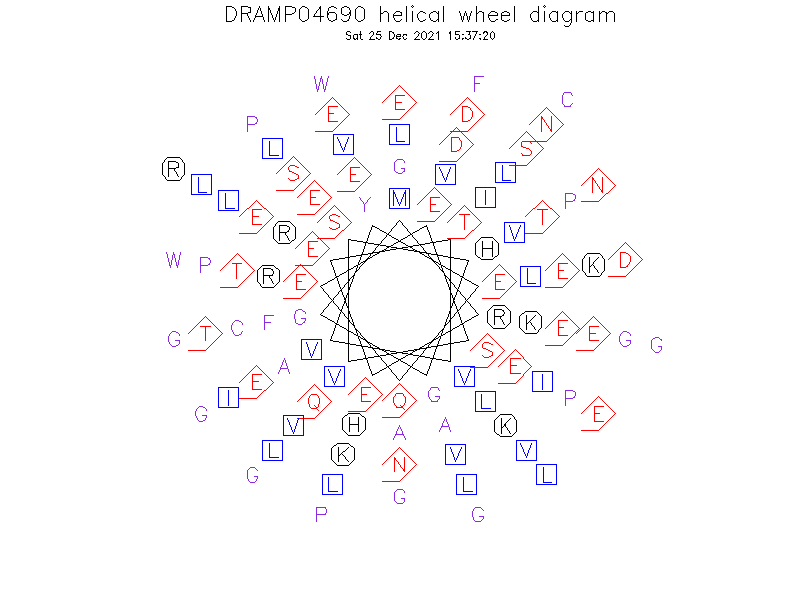General Information
-
DRAMP ID
- DRAMP04690
-
Peptide Name
- Guanine nucleotide-binding protein subunit gamma 1 (Ggamma-subunit 1;Heterotrimeric G protein gam
-
Source
- Arabidopsis thaliana (Mouse-ear cress)
-
Family
- Not found
-
Gene
- GG1
-
Sequence
- MREETVVYEQEESVSHGGGKHRILAELARVEQEVAFLEKELKEVENTDIVSTVCEELLSVIEKGPDPLLPLTNGPLNLGWDRWFEGPNGGEGCRC
-
Sequence Length
- 95
-
Protein Existence
- Protein level
Activity Information
-
Biological Activity
- Antimicrobial, Antifungal
-
Target Organism
-
- Fungi: Alternaria brassicicola, Plectosphaerella cucumerina and Fusarium oxysporum.
-
Hemolytic Activity
-
- No hemolysis information or data found in the reference(s) presented in this entry
-
Cytotoxicity
-
- Not included yet
-
Binding Target
- Not found
Structure Information
-
Linear/Cyclic
- Not included yet
-
N-terminal Modification
- Not included yet
-
C-terminal Modification
- Not included yet
-
Nonterminal Modifications and Unusual Amino Acids
- Not included yet
-
Stereochemistry
- Not included yet
-
Structure
- Not found
-
Structure Description
- Not found
-
Helical Wheel Diagram
-
PDB ID
- None
-
Predicted Structure
- There is no predicted structure for DRAMP04690.
Physicochemical Information
-
Formula
- C481H765N129O154S4
Absent Amino Acids
Common Amino Acids
- E
Mass
- 10607.9
PI
- 4.49
Basic Residues
- 11
Acidic Residues
- 20
Hydrophobic Residues
- 33
Net Charge
- -9
-
Boman Index
- -10000
Hydrophobicity
- -0.316
Aliphatic Index
- 97.35
Half Life
-
- Mammalian:30 hour
- Yeast:>20 hour
- E.coli:>10 hour
Extinction Coefficient Cystines
- 12615
Absorbance 280nm
- 130.05
Polar Residues
- 26
DRAMP04690

Comments Information
Function
- Guanine nucleotide-binding proteins (G proteins) are involved as a modulator or transducer in various transmembrane signaling systems. The beta and gamma chains are required for the GTPase activity, for replacement of GDP by GTP, and for G protein- effector interaction. Involved in the abscisic acid (ABA) and ethylene signaling pathways. Regulates acropetal transport of auxin (IAA) in roots and hypocotyls, and thus modulates root architecture (e.g. lateral root formation). The heterotrimeric G- protein controls defense responses to necrotrophic and vascular fungi probably by modulating cell wall-related genes expression; involved in resistance to fungal pathogens such as Alternaria brassicicola, Plectosphaerella cucumerina and Fusarium oxysporum.
Tissue specificity
- Mostly expressed in seedlings (especially at the hypocotyl/root junction), young cauline leaves, open flowers, and floral stems, and, to a lower extent, in roots (restricted to the stele), rosette leaves (restricted to veins), siliques, and unopened floral buds. Also present in hydathods.
Developmental stage
- In seedlings, first observed at the hypocotyl/root junction but later confined to the hypocotyl. In flowers, restricted to the stigm
Literature Information
- ·Literature 1
-
Title
- Arabidopsis heterotrimeric G-protein regulates cell wall defense and resistance to necrotrophic fungi.
-
Pubmed ID
- 21980142
-
Reference
- Mol Plant. 2012 Jan;5(1):98-114.
-
Author
- Delgado-Cerezo M, Sánchez-Rodríguez C, Escudero V, Miedes E, Fernández PV, Jordá L, Hernández-Blanco C, Sánchez-Vallet A, Bednarek P, Schulze-Lefert P, Somerville S, Estevez JM, Persson S, Molina A.
- ·Literature 2
-
Title
- Heterotrimeric G protein gamma subunits provide functional selectivity in Gbetagamma dimer signaling in Arabidopsis.
-
Pubmed ID
- 17468261
-
Reference
- Plant Cell. 2007 Apr;19(4):1235-1250.
-
Author
- Trusov Y, Rookes JE, Tilbrook K, Chakravorty D, Mason MG, Anderson D, Chen JG, Jones AM, Botella JR.

